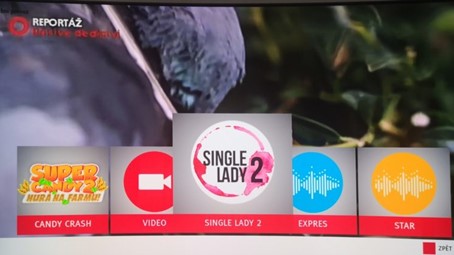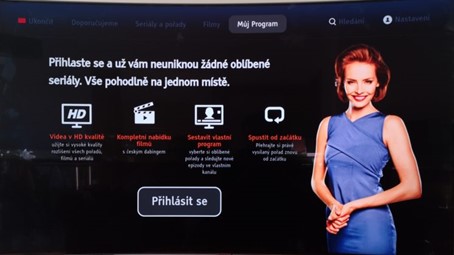In our country, hybrid broadcasting started in 2012, when Czech Television launched it on the occasion of the ice hockey championship. Óčko was the first commercial station to join, followed by Prima and Nova. Seznam TV also has its own hybrid broadcasts, and from the regional ones, for example, the UPC channel Regions+.
HbbTV provides the viewer with a superstructure of the classical linear broadcasting. A kind of modern teletext, or rather a much simplified internet. The individual TV stations decide exactly what content you get.
Four requirements for receiving HbbTV:
- A TV with HbbTV support (today practically all of them), weaker for set-top boxes
- You receive a signal from a source that broadcasts the HbbTV flag (typically DVB-T)
- You watch a TV station that broadcasts HbbTV (see below for a list of them)
- You have a TV connected to the internet
Virtually all TVs today support HbbTV, worse if you have an older model and a cheap set-top box to go with it. HbbTV has been on TVs since 2011 and you can find a list of supported models on the Czech Television or Prima website.
 The principle of HbbTV
The principle of HbbTVYou also need to receive the signal terrestrially (DVB-T), via satellite or via cable (UPC). Some operators (typically IPTV) do not broadcast the HbbTV flag as they offer similar (and better) features themselves.
Also, don't look for HbbTV on every channel. Only a few broadcasters run hybrid broadcasting (and not always on all their stations yet). And finally, you need to get internet into your TV. A wired one is the best, but Wi-Fi is also possible. You simply can't do it without an internet connection, but not everyone would think of connecting their TV to it.
You can tell that everything is working well when you switch to Czech TV, for example, and a big red button appears on the screen, usually on the bottom right.

In layman's terms, pressing the red button activates the TV's data connection and, in addition to passive TV reception, the second (data) channel starts receiving HbbTV. Hence the name hybrid broadcasting. On the screen you will see a menu prepared by the broadcaster, which you can control with a remote control. HbbTV can run as a layer before the broadcast, overlay the broadcast completely, or stay it in a window similar to the PIP function.
Something between teletext and IPTV
While HbbTV is a standard, different broadcasters have created different versions of it. It's their broadcast, so of course there's nothing stopping them. So the only common standard is in the way it is broadcast and controlled via the red button on the remote. So for some stations, HbbTV means expanding their content and video archive offerings, for others it's more like another advertising channel. Unsurprisingly, HbbTV is not free for TV stations. In short, HbbTV on Czech TV is something completely different for the viewer than HbbTV on Nova.

In the Czech Republic, the following full-screen stations broadcast HbbTV:
- Czech Television (since 2012, the first HbbTV in the Czech Republic)
- Óčko (since 2014, the first commercial HbbTV in the Czech Republic)
- Prima (since 2015)
- Nova (since 2016)
- Seznam TV (which started in 2016, before it even launched its full-screen channel)
How to turn on HbbTV on Samsung TVs:

In general, on all brands of TVs (LG, Philips, Sony, Panasonic and others), HbbTV can be easily enabled or disabled in the settings menu. On Samsung TVs, you also need to download an additional app called HbbTV to enable the reception option. However, HbbTV can only be enabled for all stations at the same time, for example you cannot receive it from Czech TV and not others. It can only be ignored - wait until the red button (sometimes with an ad) disappears from the screen.
You will probably not use much of the advantages of HbbTV 2.0 in the Czech Republic
HbbTV has several standards, the current version has the number 2.0.0. The differences are rather technical, such as support for HTML5 standards, the possibility of playing videos in high resolution and HDR (no chance of that in our country) and HEVC codec, the possibility of broadcasting a second audio track via HbbTV (also not a chance of that, it does not work even with regular broadcasting, although it could). In short, the viewer does not have to deal with the HbbTV version on his TV set.
What does each HbbTV offer?
Czech Television has a hybrid broadcast completely free of advertisements. It offers access to its iBroadcasting archive (with programmes for children in a special section), a more modern form of teletext (superteletext), EPGs of its stations, specials on sporting events, non-broadcast news, snow news and webcams from mountain resorts in the Panorama section, a bar from Czech TV 24 (which can also be switched on on another channel) and children's quizzes.

Óčko had HbbTV as the second station in the Czech Republic. It allows access to its other channels Express and Star in the form of an HbbTV app and is full of ads. The only useful feature I find subjectively is the one under the fireplace title.


Prima now has a completely new interface and it can do a lot. Prima's HbbTV includes many full episodes of its own shows, browsing shows by category and even access to movies and cartoons. Some require logging in with an iPrima account and, with a paid account, allow ad-free viewing. Prima here offers the purchase of a daily subscription to O2 TV and its sports channels. There is also a programme of CineStar cinemas. There is an EPG of its own stations and weather forecast. Prima's hybrid broadcasts are already so comprehensive that I sometimes got lost in them.

Nova has only a simple HbbTV. It includes tabloid news from the TN.cz website, EPGs of its stations, weather forecast and short videos from its shows. There is no archive access, but I also didn't come across a large number of ads. Nova simply doesn't offer much on HbbTV, only short previews of endless series like Ordinace and Ulice.

Seznam TV offers access to its archive of streaming shows via HbbTV. When you browse, you can still see the current broadcast in a small window.
Hybrid broadcasting is not for everyone
Prima estimates that up to two million viewers a month use HbbTV in the Czech Republic. However, hybrid broadcasting is not for the more demanding users. Navigating through it is still a bit clunky and the transition between classic and data broadcasting is far from "seamless". Each HbbTV contains multiple applications and once one is launched, sometimes there is no way to go back from it except by switching off HbbTV and relaunching it. This is also a problem for, say, Czech TV, but generally it is gradually improving in new releases.
Is HbbTV unnecessary?
Information and news is easier to access on your smartphone or tablet. You can get videos (iBroadcast, Seznam or Prima archive) on the big screen from your mobile via Chromecast, as long as they are online. HbbTV has a limitation to its development in that it is free and the operator feeds it from advertising or licence fees.
However, in a less digital household, for example with older users, access to HbbTV can be useful. Czech Television, Seznam TV and Prima offer good quality content, while Nova and Óčko are much weaker. Šlágr and Barrandov have also tested (or are testing) hybrid broadcasting, but this brings me back to the previous subtitle.
Source: cnews.cz
